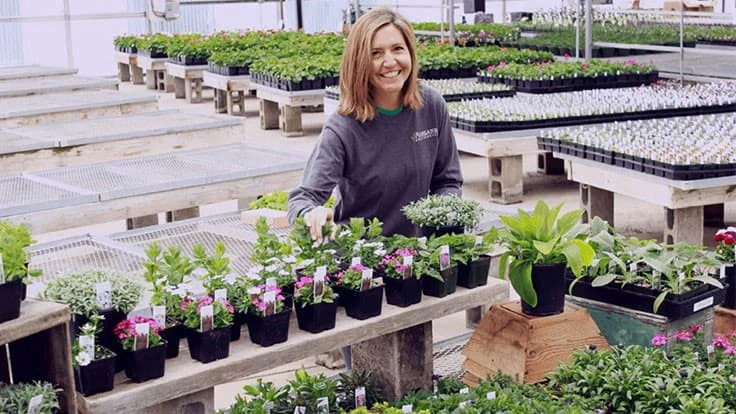

When the fourth-generation owners of Ashland Greenhouses approached Kelly Brainard about buying their 100-year-old family business, she didn’t hesitate. “It was an opportunity I couldn’t refuse,” says Brainard, a former high school horticulture teacher.
Brainard had developed a close partnership with the Williams family that owned Ashland Greenhouses, as they supplied plant material for the high school horticulture program she taught. “I knew it was a reputable company and the owners were good managers,” she says. “Their kids weren’t interested in taking over the family business, so they asked me.”
After Brainard and her husband, Ben, purchased Ashland Greenhouses in January of 2007, previous owners Valri and Greg Williams worked with her for two years to smoothly transition the business. Valri, a certified public accountant, taught her the ins and outs of business management, while husband Greg showed her all the details she’d oversee as head grower of the Oregon-based operation.
Teaching growth
Brainard was fortunate to inherit several tenured managers when she took over Ashland Greenhouses. She says she “never would have survived without the phenomenal team” that Williams had put in place.
But last year, Ashland’s production manager retired after 50 years with the company. The wholesale manager, who had been there for 30 years, also left.
“We knew it was coming,” Brainard says, “so we were keeping an eye out for seasonal staff members who had the makings of potential managers.”
By the time the production manager announced his retirement, his replacement had already been working alongside him for a couple of years to transition into the role. These informal mentorships have been key to transferring knowledge throughout the company.
When it came to training seasonal laborers, Brainard wanted to make the process easier for managers. Putting her teaching experience into action, she revamped the company’s training manual to create detailed checklists, guidelines and written procedures for each position.
“Because of the seasonality in our industry, training is one of the biggest jobs that we spend the most time doing,” she says. Written procedures “make things so much easier and more consistent because everyone’s hearing the same thing.”
When training new employees, Brainard reminds managers that: “The most important thing is to train them so they don’t rely on you,” she says. “Your goal is to train them to be independent.”

Exploring new crops
Ashland Greenhouses grows a huge selection of ornamental annuals, perennials, vegetables and hanging baskets in 31 greenhouses spanning 65,000 square feet on a 10-acre parcel. Plants are sold retail through the onsite garden center and wholesale to other independent garden centers throughout Southern Oregon and Northern California.
The company also offers contract growing services for landscapers and other growers. Over the last few years, this service has ushered in a new crop into Ashland Greenhouses: hemp.
“A lot of growers, like myself, are dealing with the decision of whether or not to get into the hemp business,” says Brainard, who was hesitant at first. “I didn’t want to make huge investments in it, and I didn’t want it to affect our spring production.”
But when she realized that contract hemp growing could actually bolster the off-season without having an impact on peak production, she decided to give it a try — starting small about five years ago.
“The deciding factor was realizing how easily it feathered into what we were already doing,” Brainard says. “It’s the same concept (as other contract growing) — just with a different product.”
Registering through the Oregon Department of Agriculture and acquiring additional insurance were easier tasks than Brainard expected. Plus, the timing of the hemp crop also worked to her advantage.
“Normally, we’d be laying off our transplanting crew around the first of May, when production is dwindling,” Brainard says. “But with hemp, that’s when you’re starting to sow seed, so it enabled us to retain our production crew for an extra two months.”
Hemp growers supply seed to Ashland Greenhouses, where it’s sown in plug trays. Some customers pick up the palletized plug trays the next day, while others wait until the hemp starts have grown to transplantable size.
Improving efficiency
Since Ashland grows most crops from cuttings, plugs and liners, starting hemp from seed required some minor production adjustments. After hand-sowing at first, Brainard invested in two seed-sowing machines to improve her crew’s efficiency.
“One of the biggest challenges is determining the best equipment for your production needs,” she says. “You always get salesmen at your door with all this fancy equipment, but it has to make sense for you and the size of your operation.”
Brainard continues to add automated equipment to make manual tasks like sowing and transplanting easier, while upgrading other systems, like irrigation, to keep the operation running smoothly. She also evaluates the space efficiency of the greenhouse, constantly looking for opportunities to streamline processes.
“We really focus on being more and more efficient over the years,” Brainard says. “You have to think outside the box, because improved efficiencies often happen when you stop doing the same thing you’ve been doing year after year.”

Explore the April 2020 Issue
Check out more from this issue and find your next story to read.
Latest from Greenhouse Management
- Anthura acquires Bromelia assets from Corn. Bak in Netherlands
- Top 10 stories for National Poinsettia Day
- Langendoen Mechanical hosts open house to showcase new greenhouse build
- Conor Foy joins EHR's national sales team
- Pantone announces its 2026 Color of the Year
- Syngenta granted federal registration for Trefinti nematicide/fungicide in ornamental market
- A legacy of influence
- HILA 2025 video highlights: John Gaydos of Proven Winners





